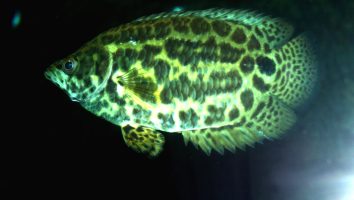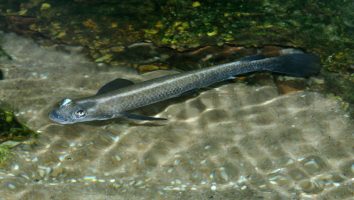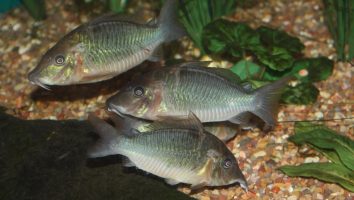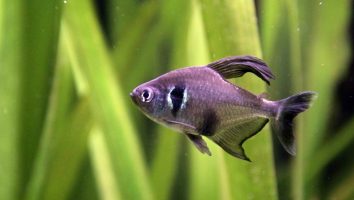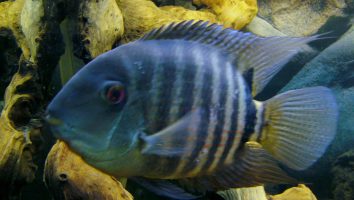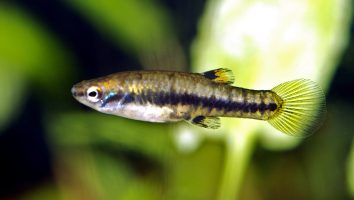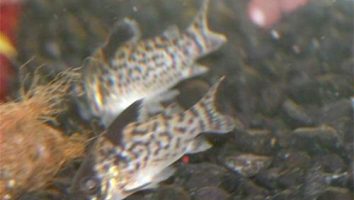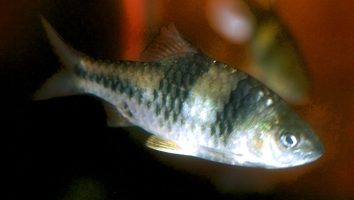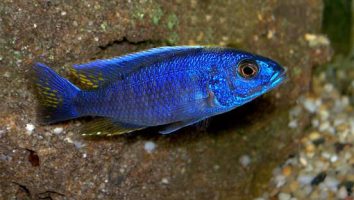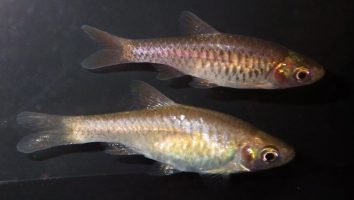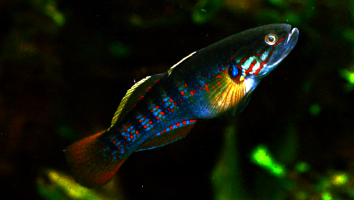The peacock gudgeon is a beautiful and unique freshwater fish that is perfect for any aquarium.
This guide will teach you everything you need to know about peacock gudgeon care. You’ll learn about their diet, size, lifespan, and more!
Table of contents
Species overview
Peacock gudgeons (Tateurndina ocellicauda) are small freshwater fish that are found in New Guinea.
They have a very unique appearance, which is what has made them popular in the aquarium trade. They are brown or black on the top half of their body with a bright blue or green on the bottom. The males also have a long, flowing fin on their tail.
Peacock gudgeons are peaceful fish that do well in a community tank. They prefer to live in groups, so it’s best to keep at least six of them together.
These fish are easy to care for and are a good choice for beginner aquarists.
Appearance
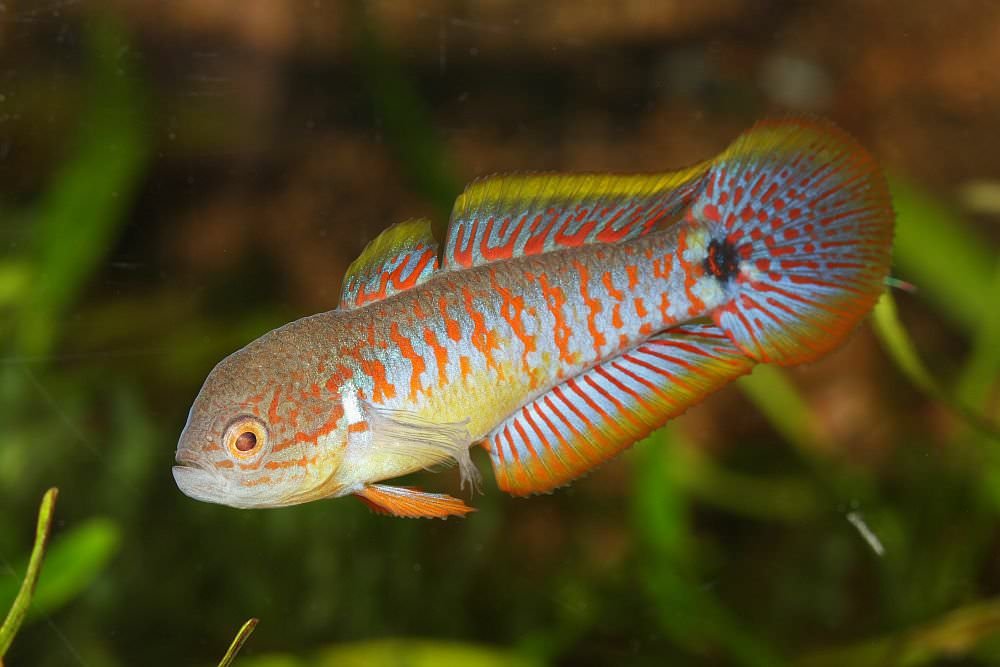
The first thing you’ll notice about the Peacock gudgeon is their beautiful coloration. These fish have a metallic blue sheen that runs from the top of their head all the way down to the end of their tail.
This color is broken up by a few vertical black stripes that run down the length of their body. The number of stripes will differ from fish to fish, but they usually have between 3-5.
The fins on these fish are also quite pretty. Their dorsal and anal fins are black with a blue outline. The caudal fin is forked and has a black base with a blue tip.
The Peacock gudgeon is a small freshwater fish that only gets to be about 2 inches (5 cm) in length when fully grown.
Lifespan
Peacock gudgeons have a lifespan of 3-5 years in captivity. However, their lifespan in the wild is unknown.
The major factor that impacts the lifespan of peacock gudgeons is the quality of water they live in. Poor water quality will shorten their lifespan significantly.
Another factor that impacts their lifespan is their diet. If they don’t have a varied and nutritious diet, they won’t live as long as they could.
Size
These little guys only grow to be about 2 inches in length.
Tank
Tank Size
The recommended minimum tank size for peacock gudgeons is 10 gallons. This is assuming you’re keeping them in a school of at least 5 or 6 fish (which you should).
We personally recommend a slightly larger tank if you can accommodate it. Every extra space will make a big difference and allow you to keep a larger school or more tank mates if you’re interested in a community tank.
Water Parameters
The peacock gudgeon is a freshwater fish that is a popular choice for many aquariums. They are hardy fish that are relatively easy to care for. However, there are still some things that you need to know about their water parameters in order to keep them healthy.
The peacock gudgeon is a tropical fish, so they need warm water. The ideal temperature for their tank is between 75 and 82 degrees Fahrenheit. They also need a pH level between 6.5 and 7.5.
The peacock gudgeon is a peaceful fish that does well with other peaceful fish. They are not aggressive and will not bother other fish in the tank.
- Water Temperature: 75-82 degrees Fahrenheit
- pH Levels: 6.5-7.5
- Water Hardness: Not applicable
- Alkalinity Levels: Not applicable
What To Put In Their Tank
Peacock gudgeons are a peaceful species of freshwater fish that do well in most aquariums. They’re not too picky when it comes to the set-up of their tank, but there are a few things you should keep in mind.
The first is the substrate. These fish love to sift through the substrate in search of food, so a soft substrate like sand is ideal. This will prevent any damage to their delicate fins.
Another important thing to consider is the plants in their tank. Peacock gudgeons are known to nibble on plants, so you’ll want to choose something that can withstand a little bit of abuse (hornwort or java moss are good choices).
You can also include some driftwood and rocks in their habitat. These will provide some hiding places for your fish and help make the inside of the tank look more natural.
Just be sure to avoid anything too sharp or jagged. These fish are known to be a little bit clumsy, so they could hurt themselves on anything that’s not smooth.
Common Diseases
Peacock gudgeons are a pretty hardy species of fish. They aren’t too susceptible to disease and can usually withstand a fair amount of abuse.
With that being said, there are still a few things that you need to watch out for. The most common problems that these fish face are parasites and infections.
The most common parasite is ich. This will show itself as white spots on the body of your fish. If left untreated, it can be deadly.
The other main problem that these fish face is infection. This is usually the result of a wound that becomes infected. The most common cause of these wounds is fighting with other fish (usually of the same species).
If you notice any cuts or scrapes on your fish, it’s important to treat them immediately. The best way to do this is to use a wound healing gel that you can find at your local pet store.
In general, the best way to keep your peacock gudgeons healthy is to provide them with clean water and a good diet. If you do this, they will be much less likely to get sick.
Behavior & Temperament
The peacock gudgeon is a peaceful fish that does well in a community tank. It’s an active swimmer and enjoys being around other fish.
While it’s not a particularly aggressive fish, the peacock gudgeon can be territorial with other gudgeons. If you keep more than one peacock gudgeon in your tank, make sure there is plenty of space for them to coexist peacefully.
The peacock gudgeon is also known to be a bit of a jumper, so be sure to have a lid on your tank!
This fish is relatively easy to care for and is a good choice for beginner aquarists.
Tank Mates
Peacock gudgeons are best kept in a species tank. They can be kept with other fish, but it’s often not worth the risk.
The main issue is that these fish are small and delicate. They’re easily outcompeted for food and can be bullied by larger or more aggressive tank mates.
As a result, they’re often the first to show signs of stress and the first to succumb to disease.
The other problem is that they’re not very common in the aquarium trade. As a result, they’re not always easy (or cheap) to replace.
If you do want to keep them with other fish, the best tank mates are small, peaceful, and not too aggressive. Some good choices include:
- Corydoras catfish
- Otocinclus catfish
- Dwarf gouramis
- Neon tetras
- Harlequin Rasboras
- Endler’s livebearers
Breeding
The peacock gudgeon is a great candidate for the home aquarium. They’re small, peaceful, and easy to care for. They’re also easy to breed!
To increase your chances of success, start by setting up a breeding tank. It should be at least 10 gallons in size with a well-sealed lid. Add a layer of fine gravel to the bottom and some plants for cover.
Then, fill the tank with clean water. Peacock gudgeons prefer slightly acidic water, so aim for a pH of 6.5. The water should also be on the softer side with a dH range of 5 to 10.
When ready, add two males and two females to the tank. Peacock gudgeons are polygamous, so the males will compete for the attention of the females.
Within a few days, the females will start to lay eggs. They’ll lay them on the plants or on the gravel. Once the eggs have been laid, the males will fertilize them.
After that, it’s just a waiting game. The eggs will hatch in about a week. When they do, remove the adults from the tank. They’ll eat the fry if given the chance.
The fry are very small and need special care. They’ll need to be fed live foods like baby brine shrimp or micro worms. You can also offer them finely ground flake food.
As they grow, you can start to introduce them to larger foods. They’ll eventually be able to eat the same things as the adults.
Conclusion
Peacock gudgeons are a great addition to any community tank. They’re peaceful, easy to care for, and have beautiful colors that will brighten up your aquarium.
We think they’re a great option for beginner aquarists or experienced fish keepers who want a low-maintenance fish.
If you’re looking for a new fish to add to your tank, we recommend giving peacock gudgeons a try!

